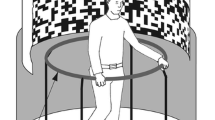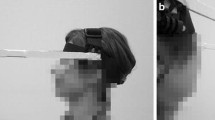Abstract.
Previous studies investigated adaptive properties of a podokinetic (PK) system that senses and controls angular movement of the trunk relative to the stance foot when walking around a curved trajectory or during rotational stepping on the spot. In particular, after adaptively modifying the PK system by prolonged stepping-in-place over the axis of a horizontally rotating platform, blindfolded subjects could no longer step in place on firm ground. When trying to do so they invariably rotated themselves relative to space without perceiving their rotation, a phenomenon termed podokinetic after-rotation (PKAR). It is well known that normal rotational stepping generates a specifically podokinetic component of compensatory nystagmus which is independent of the VOR. The present study investigated whether during PKAR this podokinetic component of oculomotor activity follows the somatosensory correlate of actually stepping around, or the cognitive intent or percept of 'no rotation'. Experiments were conducted in two phases on five normal human subjects. In the first phase, the normal passively induced VOR was compared with the combined VOR and PK oculomotor response induced by intentional rotational stepping on the spot. In both cases the angular stimulus was a 2-min rotation at 15°/s. Subtraction of the decaying VOR from the actively induced combined response revealed a constant podokinetic nystagmus with slow-phase velocity gain of about 0.4 maintained throughout this period. The PK and VOR response components appeared to sum linearly. In the second phase, we measured oculomotor activity during PKAR, when the blindfolded subjects involuntarily rotated themselves at around 15°/s while attempting to step-in-place after the podokinetic adaptation procedure noted above. The striking result of the second phase of experiments was that, although an apparently normal decaying VOR was present, the maintained PK component of response was consistently absent, despite an essentially normal physical pattern of rotational stepping. Thus, in the adapted state, non-vestibular oculomotor activity followed the cognitive intent or percept of 'no rotation', rather than the prevailing somatosensory-motor activity of the lower limbs. The finding points to an important cognitive element in this form of oculomotor control.
Similar content being viewed by others
Author information
Authors and Affiliations
Additional information
Electronic Publication
Rights and permissions
About this article
Cite this article
Weber, K., Fletcher, W., Melvill Jones, G. et al. Oculomotor responses to on-axis rotational stepping in normal and adaptively altered podokinetic states. Exp Brain Res 135, 527–534 (2000). https://doi.org/10.1007/s002210000550
Received:
Accepted:
Issue Date:
DOI: https://doi.org/10.1007/s002210000550




